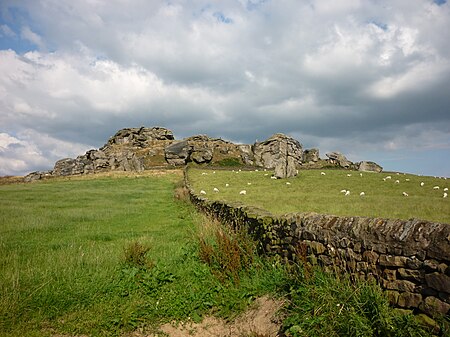Almscliffe Crag
Climbing areas of EnglandLandforms of North YorkshireMountains and hills of North YorkshireRock formations of EnglandSites of Special Scientific Interest in North Yorkshire ... and 2 more
Tourist attractions in North YorkshireUse British English from December 2018

Almscliffe Crag, or Almscliff Crag, also known as Great Almscliff Crag to distinguish from Little Almscliff, 3 miles (5 km) north west, is a Millstone Grit outcrop at the top of a small hill near the village of North Rigton, between Leeds and Harrogate in North Yorkshire, England. The crag lies on the boundary of the civil parishes of North Rigton and Stainburn. The crag was formed due to the softer adjacent strata of shale and mudstone eroding at a faster rate than the hard wearing millstone.The crag is a Site of Special Scientific Interest.
Excerpt from the Wikipedia article Almscliffe Crag (License: CC BY-SA 3.0, Authors, Images).Almscliffe Crag
Crag Lane,
Geographical coordinates (GPS) Address Nearby Places Show on map
Geographical coordinates (GPS)
| Latitude | Longitude |
|---|---|
| N 53.9365 ° | E -1.5931 ° |
Address
Matterhorn Arete
Crag Lane
LS17 0ER , Stainburn
England, United Kingdom
Open on Google Maps










